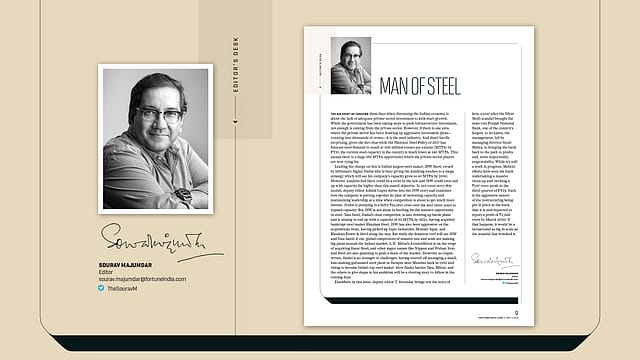
The big point of concern these days when discussing the Indian economy is about the lack of adequate private sector investment to kick-start growth. While the government has been taking steps to push infrastructure investment, not enough is coming from the private sector. However, if there is one area where the private sector has been drawing up aggressive investment plans—running into thousands of crores—it is the steel industry. And that’s hardly surprising, given the fact that while the National Steel Policy of 2017 has forecast steel demand to stand at 300 million tonnes per annum (MTPA) by FY31, the current steel capacity in the country is much lower at 140 MTPA. This means there is a huge 160 MTPA opportunity which the private sector players are now vying for.
Leading the charge on this is India’s largest steel maker, JSW Steel, owned by billionaire Sajjan Jindal who is busy giving the finishing touches to a mega strategy which will see his company’s capacity grow to 45 MTPA by 2030. However, analysts feel there could be a twist in the tale and JSW could even end up with capacity far higher than this stated objective. In our cover story this month, deputy editor Ashish Gupta delves into the JSW story and examines how the company is putting together its plan of increasing capacity and maintaining leadership at a time when competition is about to get much more intense. Jindal is pumping in a hefty ₹65,000 crore over the next three years to expand capacity. But JSW is not alone in battling for the massive opportunity in steel. Tata Steel, Jindal’s close competitor, is also drawing up battle plans and is aiming to end up with a capacity of 30 MTPA by 2025, having acquired bankrupt steel maker Bhushan Steel. JSW has also been aggressive on the acquisitions front, having picked up Ispat Industries, Monnet Ispat, and Bhushan Power & Steel along the way. But while the domestic turf will see JSW and Tata battle it out, global competitors of massive size and scale are making big plans around the Indian market.
L.N. Mittal’s ArcelorMittal is on the verge of acquiring Essar Steel, and other major names like Nippon and Wuhan Iron and Steel are also planning to grab a share of the market. However, as Gupta writes, Jindal is no stranger to challenges, having started off managing a small,loss-making galvanised steel plant in Tarapur near Mumbai back in 1982 and rising to become India’s top steel maker. How Jindal battles Tata, Mittal, and the others to give shape to his ambition will be a riveting story to follow in the coming days.
January 2026
Netflix, which has been in India for a decade, has successfully struck a balance between high-class premium content and pricing that attracts a range of customers. Find out how the U.S. streaming giant evolved in India, plus an exclusive interview with CEO Ted Sarandos. Also read about the Best Investments for 2026, and how rising growth and easing inflation will come in handy for finance minister Nirmala Sitharaman as she prepares Budget 2026.
Elsewhere in this issue, deputy editor T. Surendar brings you the story of how, a year after the Nirav Modi scandal brought the state-run Punjab National Bank, one of the country’s largest, to its knees, the management, led by managing director Sunil Mehta, is bringing the bank back to the path to profits and, more importantly,respectability. While it’s still a work in progress, Mehta’s efforts have seen the bank undertaking a massive clean-up and clocking a ₹247 crore profit in the third quarter of FY19. Such is the aggressive nature of the restructuring being put in place at the bank that it is now expected to report a profit of ₹2,266 crore by March 2020. If that happens, it would be a turnaround as big in scale as the scandal that wracked it.
(This was originally published in the May 2019 issue of the magazine. )
